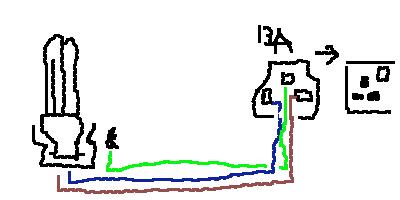Thanks everyone.
I think I've got more of an idea what's going on.
I have changed a bulb before but I haven't ever made my own lamp, straight from a wall socket. It just feels to me a bit awkward, I guess.
This, and your first message, are not particularly clear about what you are trying to do.
If you feed a light from a wall socket you need to check first that the socket is capable of supplying another feed hardwired into it. Be aware of adding to spurs and sockets and junction boxes already supplying a spur on ring circuits.
From the socket wiring usually 2.5 mm2 cable will supply a fused connection unit, typically with a 3 or 5 amp fuse. This can be switched or unswitched. From here 1.0 or 1.5 mm2 cable to the light, and light switch as required. All bare earth wires sleeved with green and yellow sleeving, and all connected together.
Or are you intending on just plugging the light into the wall socket??
Apologies if I have misunderstood your posts - they don't make a lot of sense.



